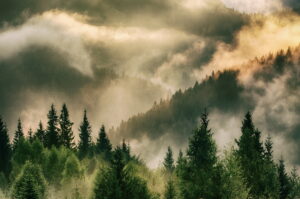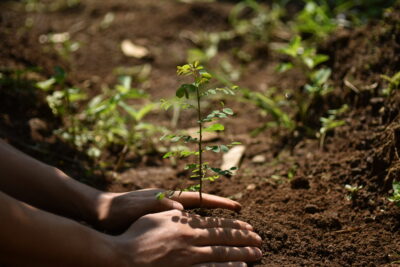In the mid 19th century, many farmers in the centrally located states of the USA were struggling with erosion. To counteract the loss of fertile soil due to storms, wind and water, they planted trees. The politician and farmer Julius Sterling Morton was consequently one of the first to reforest his property. After only a short time soil erosion decreased and biodiversity increased. As a result Morton requested the introduction of an “Arbor Day” so that everyone would always remember these important accomplishments of trees. In 1872 “Arbor Day” was celebrated for the first time in Nebraska, then 20 years later throughout America. In the meantime trees are honoured and trees are planted all over the world on this day.
Nowadays we are aware that trees accomplish much more than just erosion protection. Trees not only hold the Earth with their roots and are connected to each other through the root system, they also connect every part of Planet Earth. Ultimately their lives are inextricably linked to all life and thus to human beings. For the trees produce oxygen (whereby each tree keeps two people alive), give us wood and fruit, provide shade on hot days, form habitats for countless animals and plants and regulate the climate and the water cycle.

When we talk about the water cycle, we usually first think of the “Large Water Cycle”: Water evaporates over the oceans, rises, condenses into clouds, is transported by winds over the mainland, rains down there and finally flows back into the sea via the rivers. This cycle would theoretically also work without trees. Yet there is also the “Small Water Cycle” which, despite its name, transports gigantic masses of water tens of thousands of kilometres over land areas. This water cycle is entirely dependent on trees and forests.
It all starts with a single tree that evaporates an average of 400 litres of water per day.1)Pokorny (2019): Evapotranspiration. In: Encyclopedia of Ecology, Elsevier pp. 292-303 It does this mainly through its numerous leaves, which together form huge surfaces through and on which water constantly evaporates. This is not only water that the tree draws from the groundwater together with nutrients from its roots, but it also evaporates rainwater that remains on the leaves. The water rises, condenses as clouds and is carried on by winds until it rains down again, most of it being gathered again by trees to evaporate once more. Most of the rain is returned to the Small Water Cycle over and over again. On average, the water in the clouds is carried about 2,000 kilometres until it rains down and the cycle starts again, transporting the water far across the continents – as a “Flying River”. So it is the forests, and thus each individual tree, that create the Small Water Cycle and ensure an equal distribution of water on the Planet. The trees help planet Earth to remain in its equilibrium and provide similar conditions for every living being, at least as far as water is concerned.
There is always the same amount of water on Earth. Aridity and droughts only occur when the Flying Rivers stop flowing and the water is no longer evenly distributed. In recent years, the conversion of forests into agricultural land or settlements and the increasing deforestation for profit, have resulted,- on the whole Planet-, in around 5% less water evaporating from the Earth’s entire surface each year compared to the previous year. This has also reduced the transport of water by Flying Rivers.
The Flying Rivers are just one of many examples in nature that show how all life is interconnected. 80% of the rain in China originates in European forests and the water is transported to China via the forests of Russia. Likewise 70% of the rain in the Southern regions of South America comes from the Amazon; and North America is also dependent on the tropical rainforest of South America.2)Makarieva & Gorshkov (2020): A controversial Russian theory claims forests don’t just make rain-they make wind. The Biotic Pump Greening Group In the Northwest of the USA, it has been proven that there is already up to 20% less precipitation in summer and only half as much snow in winter due to the deforestation of the tropical rainforest in the Amazon region.3)Medvigy, Walko, Otte & Avissar (2013). Simulated Changes in Northwest U.S. Climate in Response to Amazon Deforestation, Journal of Climate, 26(22), 9115-9136.

Every drop of water comes back to us at some point via the water cycles. The nations of this Earth are connected to each other through the Flying Rivers, because Nature knows no borders. We human beings also need to work together and realise that we are all interconnected and interdependent in one way or another. When we plant a tree in Europe, as a first step we help our fellow human beings in China to get fresh drinking water. However the cycle continues and the water in China that originated in Europe will sooner or later also be needed again in Europe and, after a long journey, will also fall from the sky there as rain. If we want ourselves and all people on this Planet to have enough fresh sweet water available, we must preserve the forests of this Earth and reforest former forests. Since we have managed to hinder natural cycles such as the Flying Rivers, we also have the power and ability to restore these cycles by planting more trees again.
Let us become aware of our responsibility for the Planet and recognise that every single tree counts and makes an important contribution to the whole Planet. Do something good not only for Nature and the climate, but also for your fellow man and yourself, and plant a tree on Arbor Day, Friday April 28th, 2023 … or even two or three!
References
| ↑1 | Pokorny (2019): Evapotranspiration. In: Encyclopedia of Ecology, Elsevier pp. 292-303 |
|---|---|
| ↑2 | Makarieva & Gorshkov (2020): A controversial Russian theory claims forests don’t just make rain-they make wind. The Biotic Pump Greening Group |
| ↑3 | Medvigy, Walko, Otte & Avissar (2013). Simulated Changes in Northwest U.S. Climate in Response to Amazon Deforestation, Journal of Climate, 26(22), 9115-9136. |









